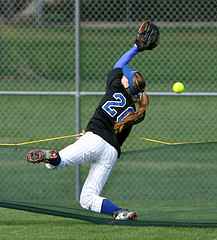Outfield skills are too often under coached.
Too often, only the weaker defenders are assigned outfield duty and the best players have determined early that they are too good to play the outfield. By the time a collegiate career comes around, many players have never been taught any of the necessary skills to play the outfield positions and thus must start at ground zero.

After years of being a shortstop (or pitcher, etc.), it is a daunting prospect for a player to move into that last line of defense. There is no reason why all players do not learn all skills at an early age, regardless of where the present team needs her talents.
At the earliest ages, outfielders are an afterthought. How many youth coaches have kids jumping up and down to play left field? There are many reasons why it is the place to put the weakest fielders: not as many balls are hit out there and they don’t come as fast.
We can get by without a strong outfield. As the level of play advances, often the coaching improves but the outfielders still too often shag a few fly balls and are admonished to “hit the cut” But the how-to-mechanics are ignored or simply not given the emphasis that they need.
All players should have a working knowledge of, and some experience in, outfield play. Overall player development should include a core group of skills imperative to strong outfield play. Overhand throwing, fielding fly balls and groundballs, footwork, communication and confidence are all crucial components of a solid outfielder.
Overhand throwing is a skill that is second nature to many good players. This fundamental aspect of the game is often lacking and should be a top priority for coaches at all levels.
The basics of proper grip—thumb under the ball with two or three fingers across seams, footwork and upper body alignment need to be broken down and drilled consistently. The warm-up time pre-practice is a daily opportunity to work on throwing and receiving mechanics. The grip should be firm, but not tight—the hand behind the ball and players should have a feeling of throwing the top of the ball to target.
From catch to release, outfielders have the biggest arc in their throwing motion. Players should turn towards their throwing side as they catch the ball (right handers with left foot forward), bring the ball and glove to the mid-line of the body, bring the ball down in an arc with their thumb towards their thigh as they prepare to extend the arm back.
At the same time, their glove arm is making a similar arc on the front side. At full extension, the player’s glove arm is up and out in front and the throwing arm is extended back with the ball facing away from the player and target. The ball should not be visible from directly in front of the player. From this point, the player drives forward, rotating her hips and shoulders down to throw.
In order to execute a throw, the player must of course first step to and catch the ball…It is critical that outfielders practice fielding ground balls and fly balls of every type and from all angles. When fielding a flyball, anticipation and proper approach are critical.
Outfielders must begin each pitch in a mid-level “ready” position, they must be balanced and know all aspects of the game situation.
When fielding any ball hit to either side, the outfielder should pivot on the foot closest to the ball, make a crossover and step and run to the ball.
Getting to top speed quickly can make or break the play. Players should turn to glove side on balls hit directly over their head in order to get maximum extension.
On fly balls, the glove should be positioned above the face and slightly to the throwing arm side. Both hands are up with thumbs together so that the throwing hand can secure the ball and ready for the extension necessary for the “big” outfield throw.
Another critical component is footwork. The player must use short steps to gain control just before fielding and use a crow hop to facilitate a strong throw. A right handed player would begin with her left foot forward and hop onto her right foot while extending her throwing arm back.
A strong hip and shoulder rotation finishes the throw over her left foot, while her right side follows through.
Communication is key all over the field. Outfielders must know where teammates are, where the fence is, have the situation in her head and have the “hit it to me” mentality that gives all players the confidence they need to make any play. Drills that break down mechanics into small parts and those that simulate game conditions are both critical to player development.
Drills and situations that can be made competitive such as throwing to targets and diving drills are fun and the repetitions make better players.Coaches should emphasize the importance of outfield skills and the excitement of game saving plays. At all levels, all players should be proficient in basic outfield skills and value the importance of the last line of defense.